Global Apparel Industry Statistics: Market Size and Trends (2025)
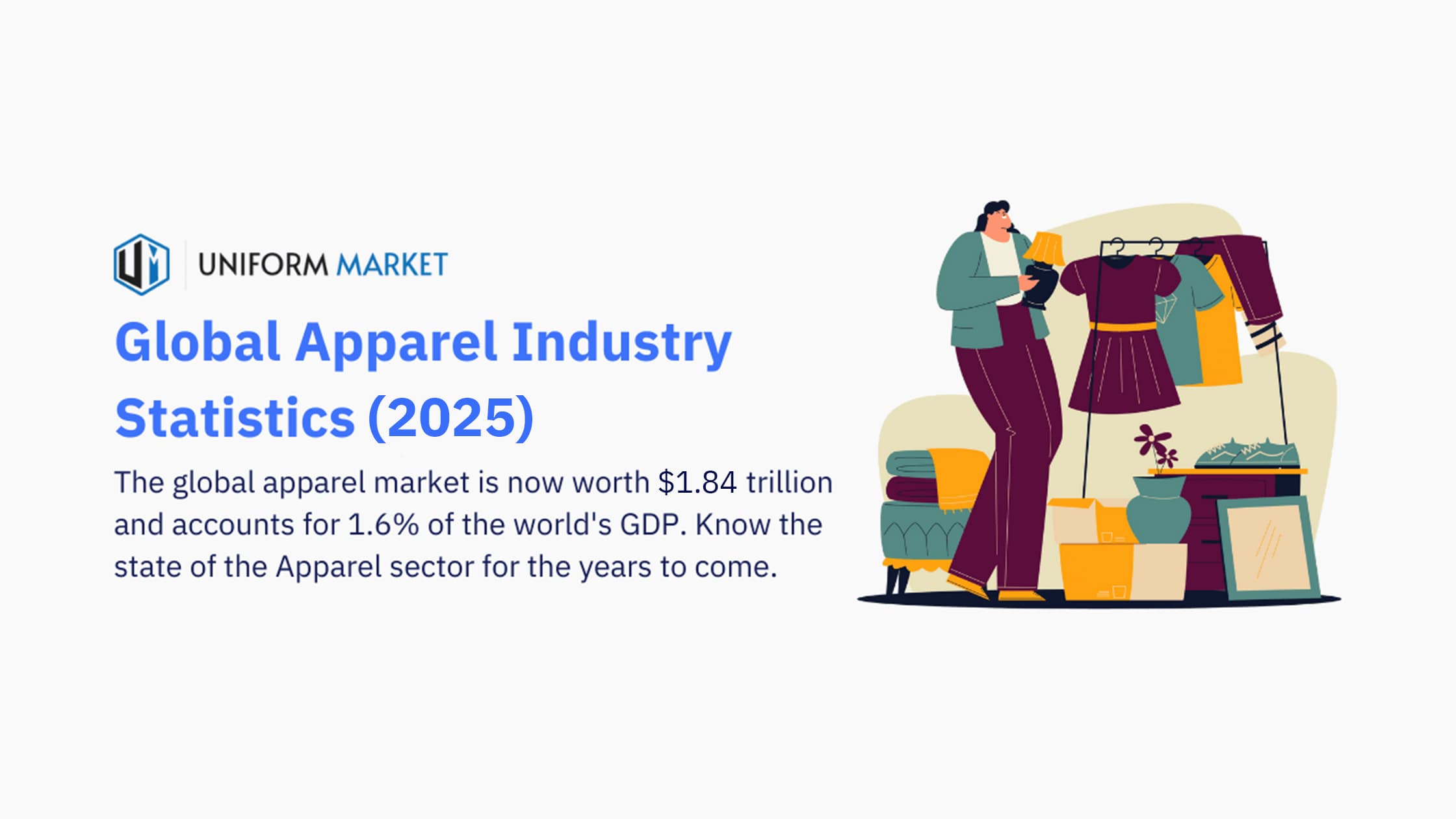
The global apparel market is worth $1.84 trillion and accounts for 1.6% of the world’s GDP in 2025. After taking a hit due to the COVID-19 outbreak, the markets have recovered and thrived with people buying 60% more clothes than they did a couple of decades ago.
Take a look at the state of the Apparel market in 2025 and beyond in this post. We will explore the market sizes, consumer behavior, employee data, and environmental impact.
Apparel Industry Statistics Highlights
- The global apparel market is valued at $1.84 trillion in 2025, accounting for 1.63% of the world’s GDP.
- Out of the global workforce of 3.62 billion people, 430 million work in fashion and textile production
- The United States apparel market is the largest in the world, with a size of $365.70 billion.
- The average US household spends around $162 per month on apparel.
- 58% of consumers tend to shop for apparel in-store rather than online.
Brief Fashion Industry Insights for 2025
- Europe’s falling inflation and increased tourism will boost the fashion industry, while growth in Asia (Japan, Korea, India) may offset uncertainty in China.
- The “Silver Generation” (50+) holds 72% of U.S. wealth, presenting growth opportunities for brands that cater to this group.
- 50% of fashion executives see generative AI as key for product discovery in 2025, and 82% of customers want AI to reduce shopping research time.
- Challenger brands in sportswear like Deckers, New Balance, and Vuori may surpass Nike, Adidas, Puma, and Under Armour in profits by 2024.
- 63% of fashion brands are lagging behind 2030 decarbonization goals, but only 18% of executives see sustainability as a top growth risk for 2025.
- Apparel consumption is expected to rise by 63% by 2030, potentially using over one-quarter of the world’s carbon budget by 2050.
Global apparel market size
The apparel market is valued at $1.84 trillion in 2025, accounting for 1.65% of the global gross domestic product. The market will experience a CAGR of 2.81% between 2025 and 2028.
The Apparel market accounts for 1.65% of the world’s GDP.
The Apparel market took a hit in 2020 due to the Covid-19 pandemic when the market size dropped by 11.46% from the previous year. That was the only year when the Apparel industry saw a downward trend in the past decade.
This table shows the global apparel market size over the years:
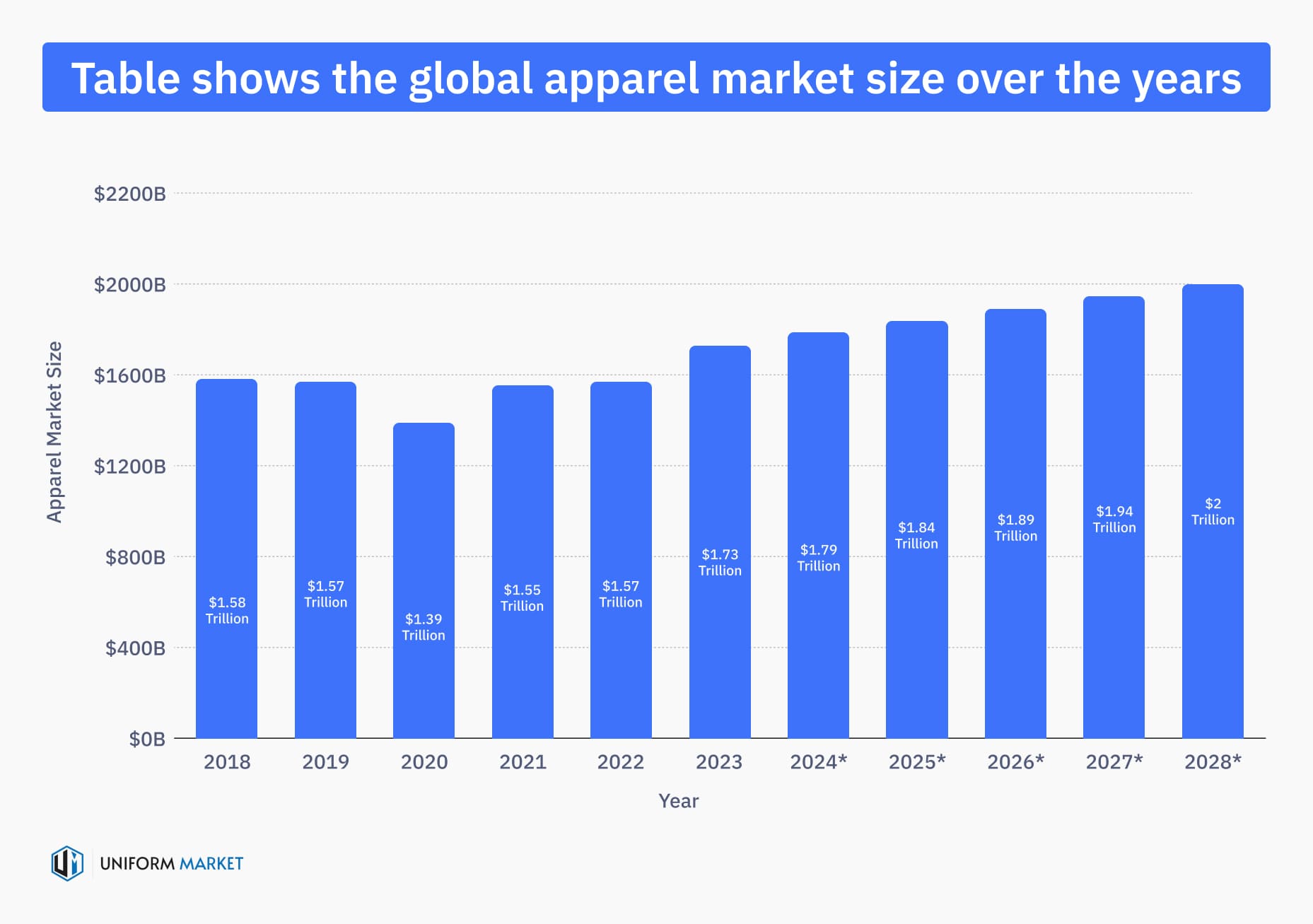
| Year | Apparel Market Size |
|---|---|
| 2018 | $1.58 trillion |
| 2019 | $1.57 trillion |
| 2020 | $1.39 trillion |
| 2021 | $1.55 trillion |
| 2022 | $1.57 trillion |
| 2023 | $1.73 trillion |
| 2024 | $1.79 trillion |
| 2025 | $1.84 trillion |
| 2026* | $1.89 trillion |
| 2027* | $1.94 trillion |
| 2028* | $2 trillion |
United States apparel market size
The United States apparel market is valued at $365.70 billion in 2025, and it is projected to grow at a CAGR of 2.11% between 2025 and 2028.
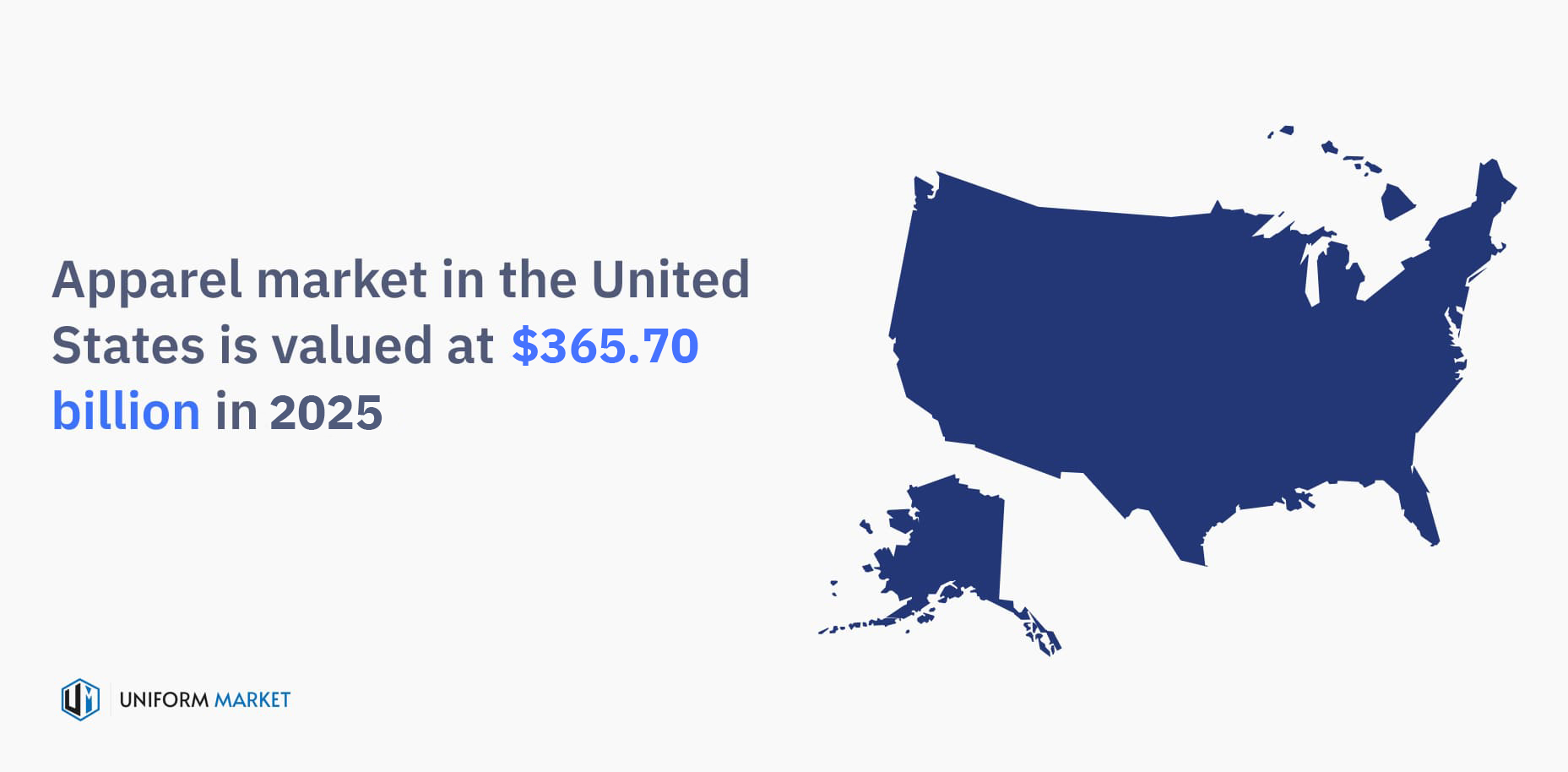
| Country | Apparel Market Size |
|---|---|
| United States | $365.70 billion |
| China | $313.82 billion |
| India | $101.39 billion |
| Japan | $87.00 billion |
| United Kingdom | $82.89 billion |
| Germany | $72.57 billion |
| Italy | $57.86 billion |
| France | $40.02 billion |
| Canada | $39.71 billion |
| South Korea | $39.06 billion |
| Brazil | $30.99 billion |
| Russia | $30.52 billion |
| Spain | $24.96 billion |
Women’s Apparel Market leads the way
The global women’s apparel market is currently valued at $930 billion and will cross the $1 trillion mark in 2027.
Men’s apparel market is worth $587.61 billion while that of Children’s is $274.25 billion.
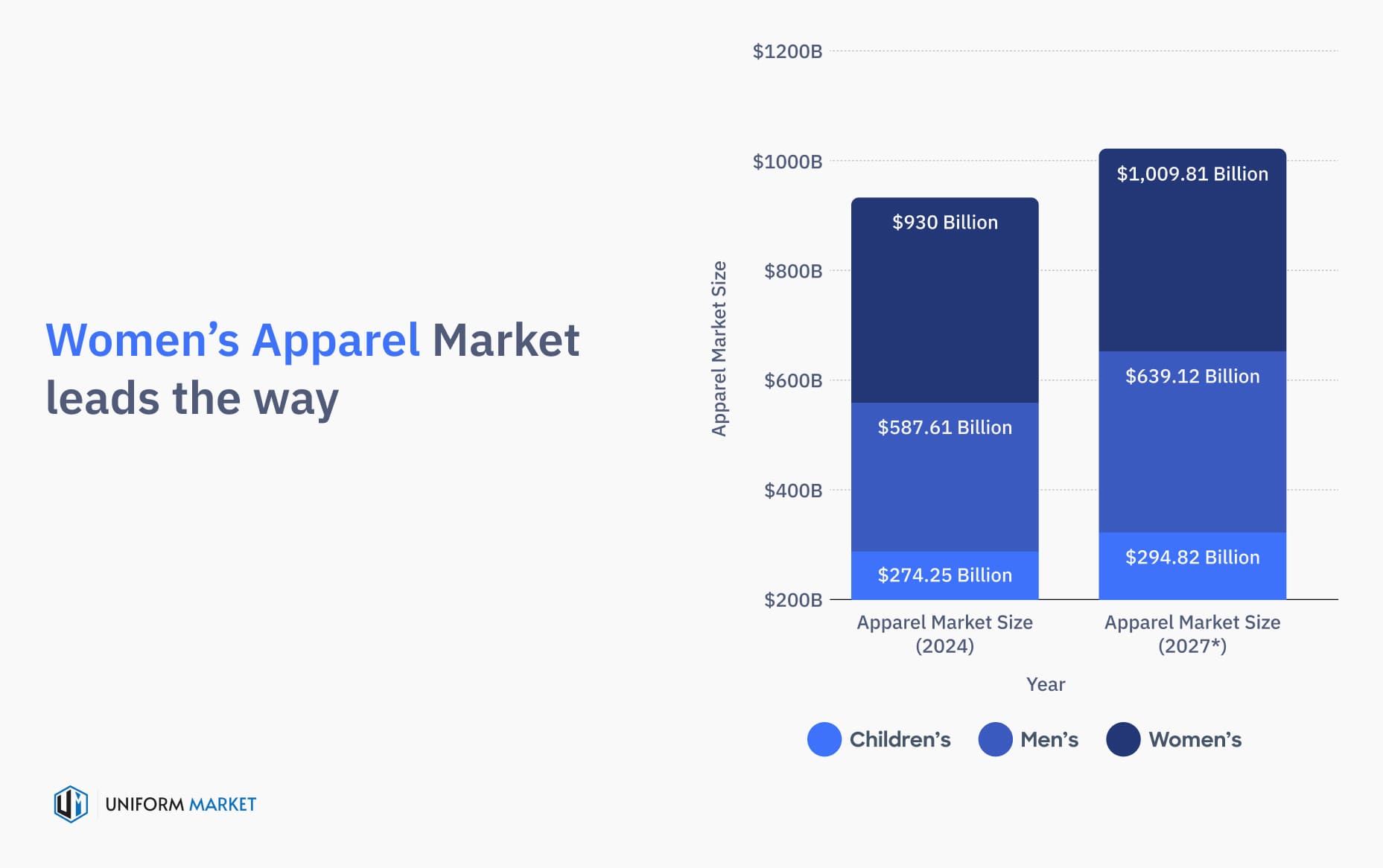
| Year | Women’s Apparel Market Size | Men’s Apparel Market Size | Children’s Apparel Market Size |
|---|---|---|---|
| 2024 | $930 billion | $587.61 billion | $274.25 billion |
| 2027* | $1,009.81 billion | $639.12 billion | $294.82 billion |
United States clothing sales
Retail clothing sales in the United States account for $25.63 billion every month on average. According to the latest data available, retail clothing sales in the US amounted to $25.84 billion in April 2024.
| Time | Retail Clothing Sales in the US |
|---|---|
| April 2024 | $25.84 billion |
| March 2024 | $25.43 billion |
| February 2024 | $25.95 billion |
| January 2024 | $25.96 billion |
| December 2023 | $26.15 billion |
| November 2023 | $25.76 billion |
| October 2023 | $25.52 billion |
Demographic that buys the most clothes
82% of shoppers worldwide aged between 26 and 35 years old have purchased clothes online in the previous 12 months. People aged 36 to 45 are most frequent clothing shoppers with 80% of them making a purchase in the past 12 months.
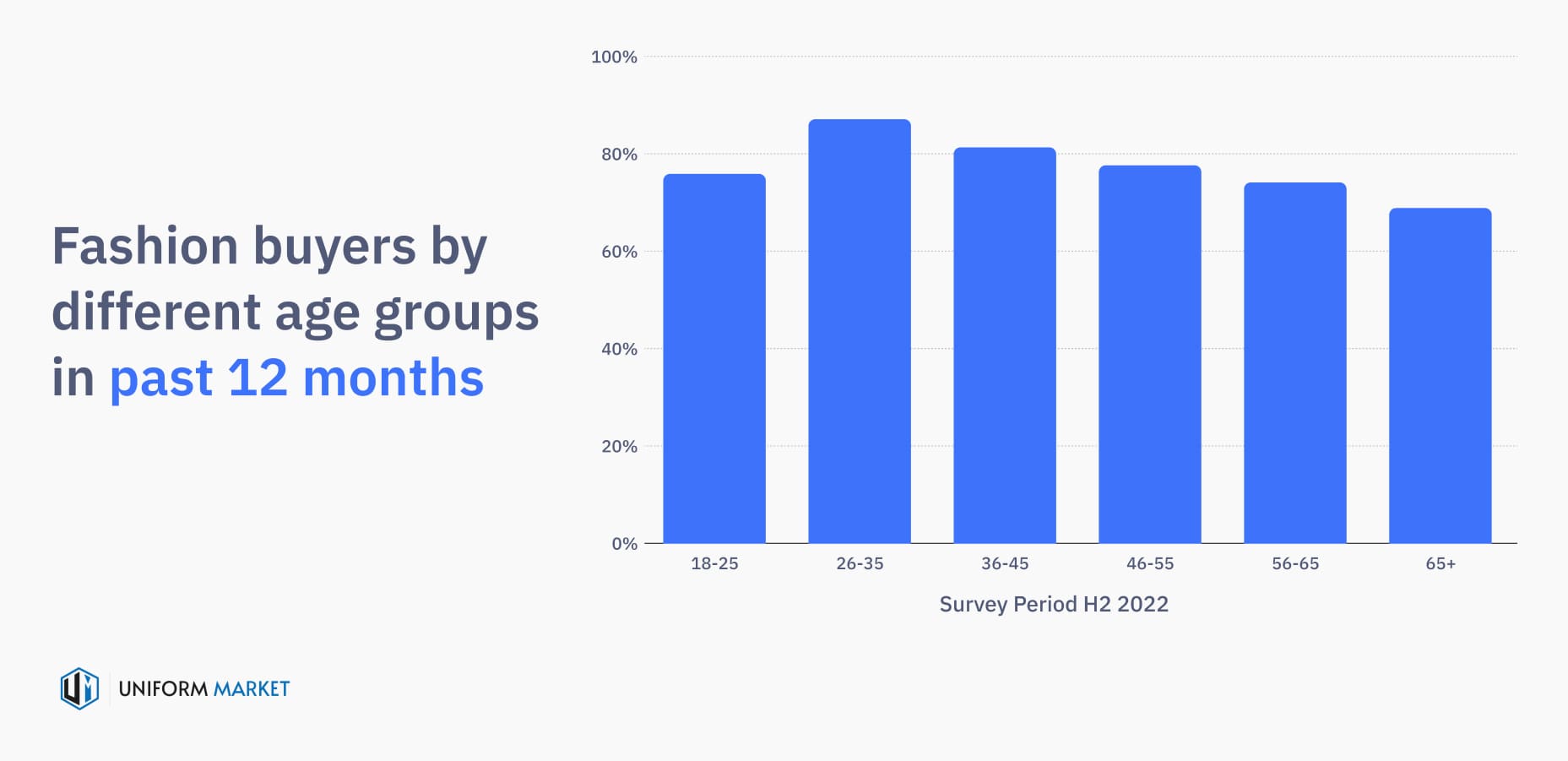
Average expenditure on clothing and footwear
The total consumer spending in the apparel industry amounts to $2.4 trillion globally, a 15.94% increase in the past decade. It is estimated that the global spending will reach $2.88 trillion by 2029.
Source: Statista
Online and offline share of total fashion retail sales worldwide
79% of fashion sales happened in stores, and only 21 percent of the fashion sales came from online sales. Asians buy the most online (24%) while Africans are the least likely to make online purchases (4.2%).
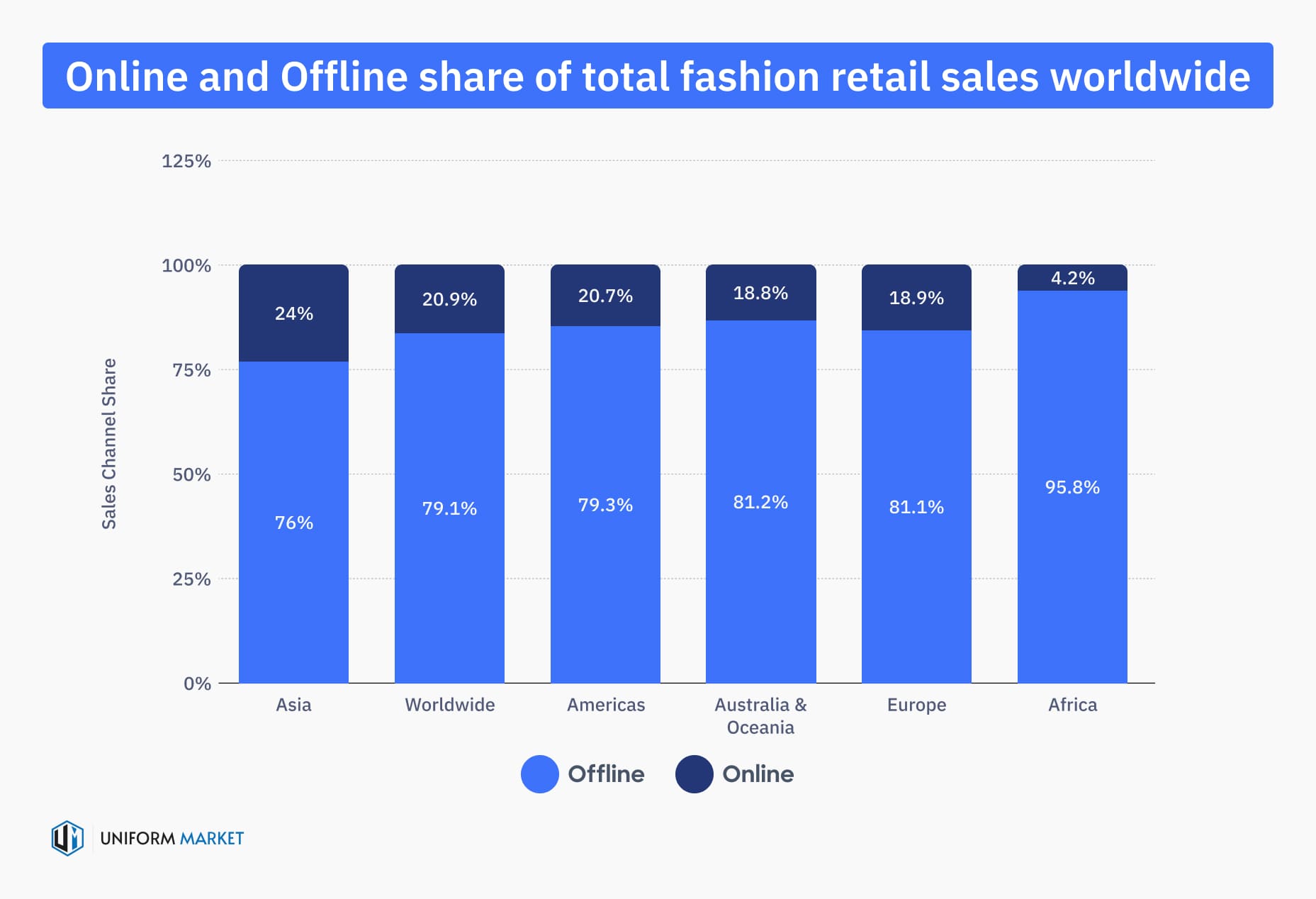
How many people work in the fashion industry?
430 million people out of the total global workforce of 3.62 billion work in the fashion sector as of 2025. The Fashion industry employs 11.9% of the global workforce.
This figure includes farming, processing, treating, finishing and logistics work among others. Much of this workforce is based in Asia.
Source: Solidarity Center, World Bank.
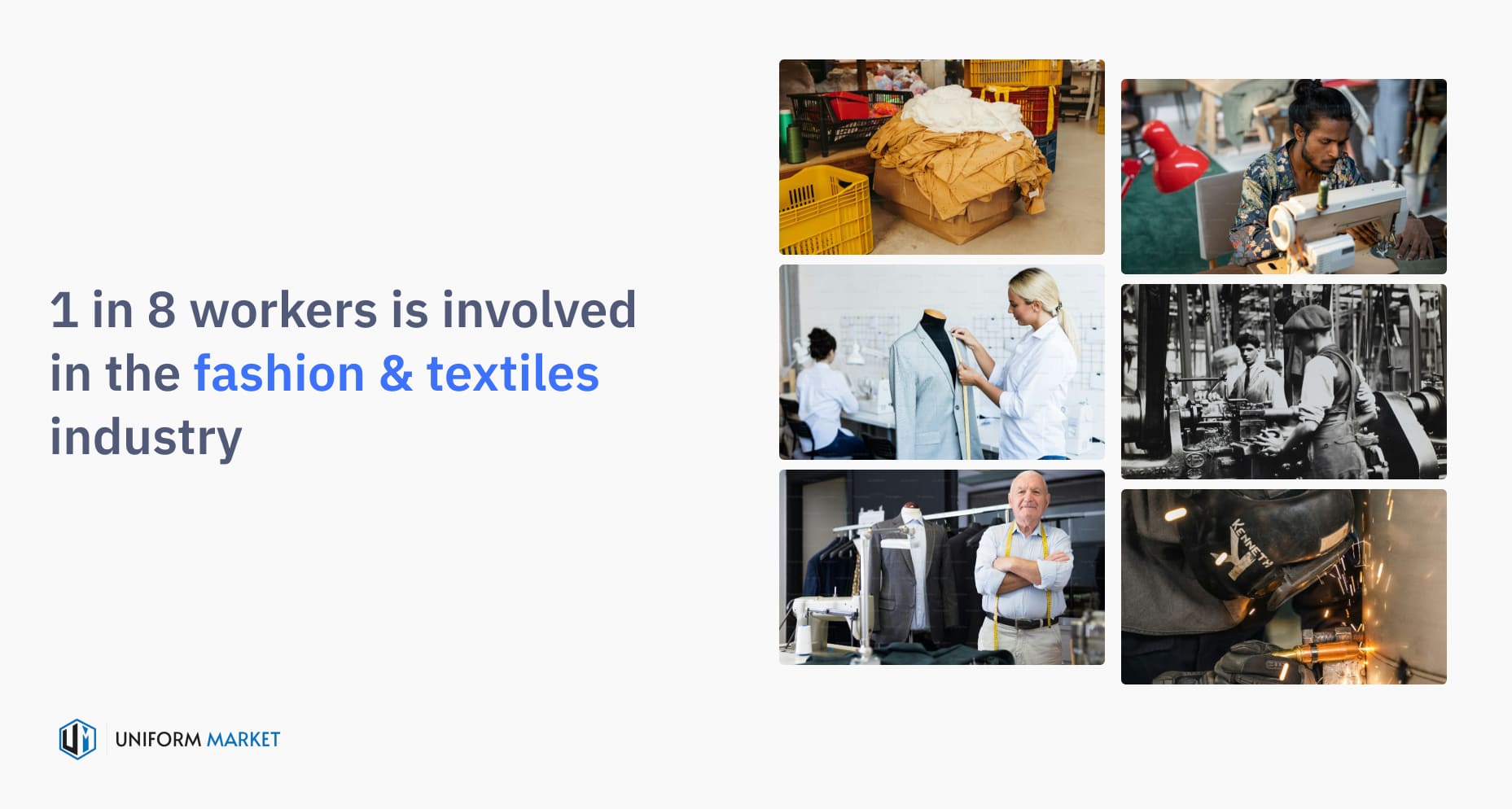
What is the success rate of clothing brands?
The cumulative industry data reveal that only 10% of clothing startups can survive in the long. The startup failure rate is 90% with 30% failing within the first two years.
- 50% businesses cant survive past the 5 year mark
- 70% business can’t survive the 10-year mark
Source: Exploding Topics, Failory, Small Business Trends.
The average American household spends on apparel
In the United States, households spend an average of $162 per month on apparel. That comes out to $1,945 per year. The average spending on apparel and services increased 10.9% in 2022, after an increase of 22.3% in 2021.
All major components of apparel and services saw an upward trend in spending, the largest being an 18.8% increase in footwear.
- The average American household spends 45.7% more on clothing compared to education.
- The average American household spends 124.5% more on clothing compared to personal care.
- The average American household spends 233.4% more on clothing compared to alcoholic beverages.
Number of clothes produced every year
It’s estimated that over 100 billion clothes are produced every year. That’s equivalent to 12.5 pieces of clothing for every person in the world.
The number of garments produced annually has doubled since the year 2000 and exceeded the 100 billion mark for the first time in 2014.
By 2030, global apparel consumption is projected to rise by 63%, from today’s 70 million tons to 105 million tons. By 2050 this figure is likely to grow by 3x than today’s amount with total clothing sales predicted to reach 160 million tons.
How many clothes does the average person have
An average person around the world owns 70 to 150 pieces of clothing. People in Europe have a bigger wardrobe than all other world regions.
- An average American women own 103 pieces of clothing.
- Adults in the UK have 118 pieces of clothing in their wardrobe.
Which country consumes the most apparel
Hong Kong is the largest consumer of apparel, with an average volume of 117.3 apparel pieces per capita. It is the only region with an average of above 100. The Netherlands comes into second spot with an average of 97.4 per capita.
Here is a table showing the per-capita volume sales in the apparel market in different countries:
| Country | Per-capita Apparel Sales Volume |
|---|---|
| Hong Kong | 117.3 |
| Netherlands | 97.4 |
| United States | 88 |
| Ireland | 75.1 |
| Croatia | 69.4 |
| Australia | 63.4 |
| Austria | 61.6 |
| United Kingdom | 60.2 |
| Sweden | 59.5 |
| Germany | 55.1 |
| Norway | 54.9 |
| Turkey | 54.7 |
| Switzerland | 52.8 |
What shoppers in the US look for when purchasing apparel
83% of US apparel shoppers say the price of the apparel is the most crucial thing while making a purchasing decision. A good 77% pay attention to ratings and reviews while purchasing apparel.
The brand of a product is one of the least considerable factors while making a purchase indicating people will buy from less popular brands with economical pricing.
Here is a table showing what shoppers pay attention to while purchasing apparel:
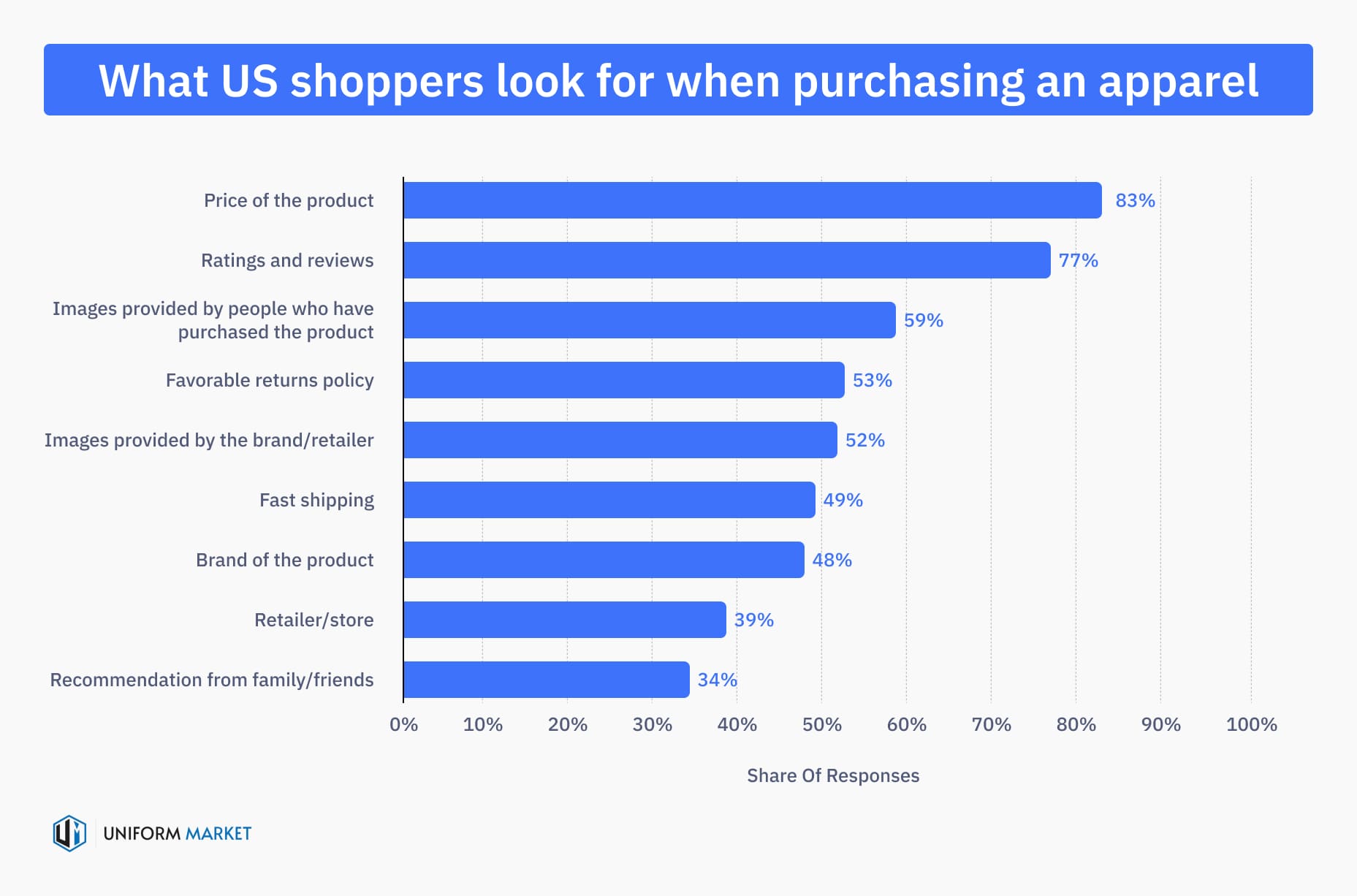
65% of consumers trust user-generated content over brand-generated content while shopping online
If we go by the age groups, 85% of 18 to 34-year-olds said it’s important to look at user-generated content versus 46% of those aged over 55.
These figures take a dip while shopping in-store — 73% of 18 to 34-year-olds and 33% of people 55 and over say they look at user-generated content before buying.
Where do shoppers find UGC content?
- Retail websites (35%)
- Brand websites (34%)
- Browser search results (27%)
- In-store displays (22%)
- A friend or family member’s social feed (20%)
57% of apparel shoppers think it's very important for a brand to be sustainable
As per The Bazaar Voice survey, 40% indicated that they prioritize personal needs and preferences over whether a brand is sustainable or fast-fashion when making clothing purchases.
Meanwhile, 27% reported buying clothing from both sustainable and fast-fashion brands, and 18% expressed a clear preference for purchasing sustainable clothing.
Global market value of the global secondhand apparel market
The global secondhand apparel market is valued at $260.24 billion as of 2025 and will continue to grow at a CAGR of 15.07% to reach $522.81 billion by 2030.
| Year | Market Size |
|---|---|
| 2023 | 196.56 billion |
| 2024 | 226.19 billion |
| 2025 | 260.24 billion |
| 2026 | 299.43 billion |
| 2027 | 344.32 billion |
| 2028 | 395.77 billion |
| 2029 | 454.78 billion |
| 2030 | 522.81 billion |
Source: Kingsresearch
What do Apparel Shoppers think of second-hand shopping?
43% of people aged 18 to 34 said they shop second-hand items “very often” or “often” compared to just 11% of people aged over 55.
66% of people over 55 said they “never” shop second-hand on platforms — only 26% of 18 to 34-year-olds had the same statement.
58% of consumers tend to shop for apparel in-store rather than online
Despite the convenience of online shopping, 58% of consumers prefer to shop for apparel in-store rather than online.
Around 61% of people search online or on social media before buying something, whether they end up purchasing online or in a store.
As pre-purchase research is important to consumers, marketers should keep their product pages up to date.
Apparel Waste and Environmental Impact Statistics
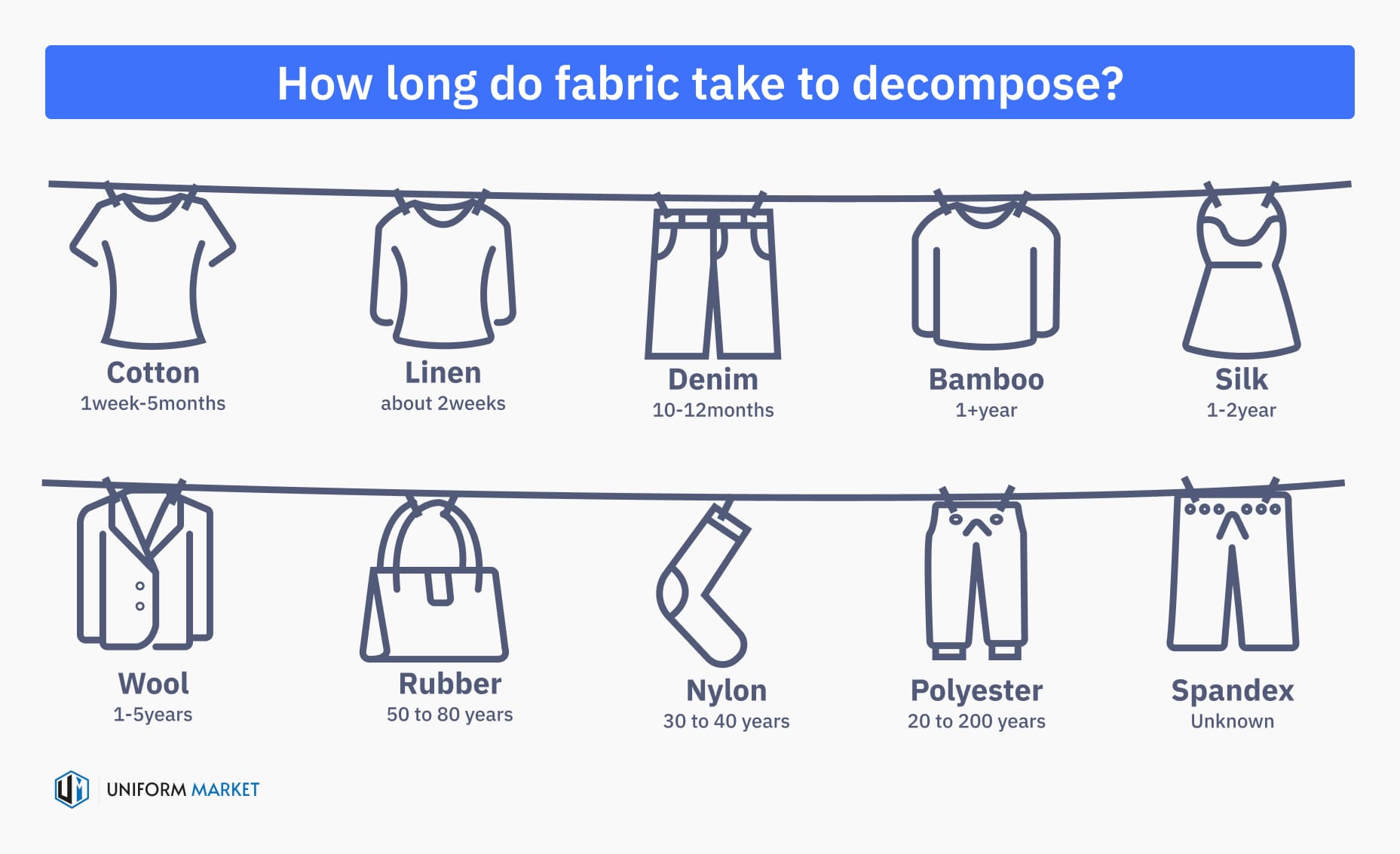
- 92 million tons of textile is discarded every year around the world. (Theroundup)
- The average US consumer discards around 81.5 pounds of clothes annually, leading to an estimated 11.3 million tons of textile waste in the country alone. (roadrunner)
- The fashion industry is responsible for 10% of annual global carbon emissions (Worldbank)
- Every year, the fashion industry uses enough water to meet the needs of five million people, which amounts to 93 billion cubic meters. (Worldbank)
- Textiles can take up to 200 years to decompose. (Roadrunner)
- Only 1% of clothes are recycled every year (Therounduporg)
- Up to 500,000 tons of microfibers end up in the ocean every year (Theroundup)
- 15% of used textiles are shipped overseas where the materials often end up in landfills anyway due to less advanced waste management systems (BU School of Public Health)
Now that you’ve gained insights into the global apparel industry, it’s the perfect time to take action. If you’re considering starting a business or expanding your current operations, our Uniform Program Management Software can help you streamline your uniform management processes. Designed to meet the unique needs of the apparel industry, our software simplifies inventory control, ordering, and distribution, ensuring your business runs smoothly from day one. Ready to get started? Contact us today to learn how we can support your success!
Ready to launch your next
Employee Program?
Uniform Programs?
Company Stores?
Group Stores?
Team Stores?
Swag Stores?
Brand Stores?
Event Stores?
Distributor Portals?
Enabling uniforms and promotional product suppliers with eCommerce solutions to manage B2B, B2B2C, and Direct selling from one central platform.

